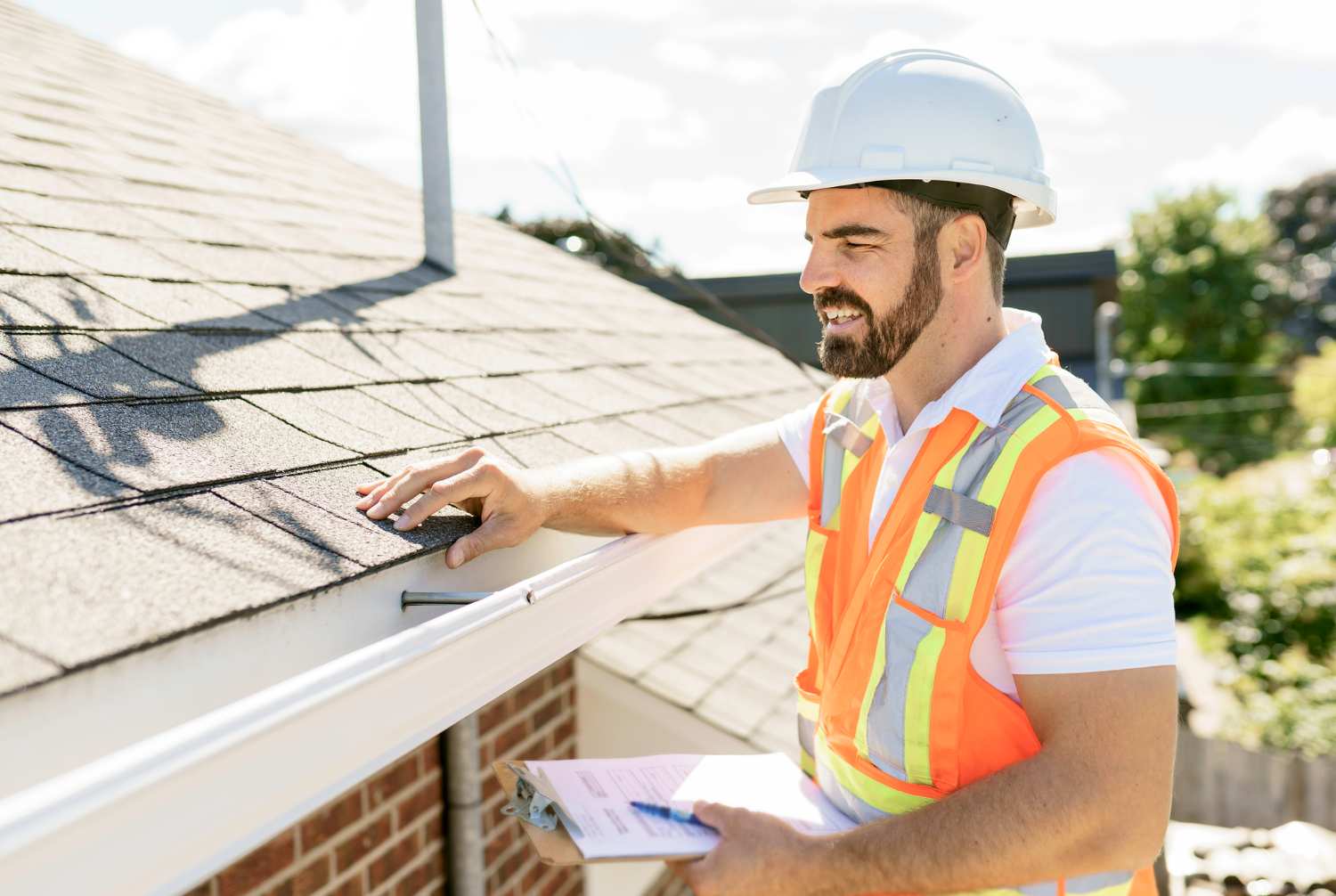As a professional roofer, conducting regular roof inspections is crucial for identifying and resolving potential issues before they become major problems. A thorough roof inspection involves examining the entire roof surface, including its components, for signs of damage or wear.
Whether you’re inspecting a roof for storm damage or assessing its general condition, this guide will provide you with the tips and tricks you need to conduct a comprehensive inspection. By following these steps, you’ll be able to pinpoint any issues, provide accurate assessments to homeowners, and ensure the integrity of the roof for years to come. So, let’s get started on mastering the art of roof inspections.
How to Inspect a Roof for Storm Damage
When it comes to inspecting a roof for storm damage, it’s important to follow a step-by-step process to ensure a thorough assessment. By knowing where to look and what to look for, you can accurately identify any potential issues caused by severe weather events.
Begin by examining the exterior of the roof. Check for loose or missing shingles, as well as any signs of wear or damage to the roof surfaces. Pay close attention to roof penetrations, such as vents or chimneys, as they are often vulnerable areas. Inspect the gutters and downspouts for clogs or signs of water damage.
When possible, gain access to the attic and inspect the pathway leading to it. Look for any signs of water stains or mold growth, as these may indicate an ongoing issue with water infiltration.
It’s crucial to consider the age of the roof as well. Different types of roofing materials have different lifespans, and older roofs may be more susceptible to storm damage. Document any findings and take photographs to provide evidence for insurance claims or discussions with the homeowners.
When to Conduct a Roof Inspection
As a roofer, it’s essential to know when to conduct a roof inspection to ensure the safety and longevity of a roof. There are several events and circumstances that warrant a thorough inspection.
Firstly, after a significant storm or severe weather event, it is crucial to inspect the roof for any potential damage. High winds, hail, or heavy rainfall can cause significant harm to a roof, such as loose or missing shingles, roof penetrations, or structural damage. Identifying and addressing these issues promptly can prevent further deterioration and potential leaks.
Secondly, if a homeowner notices a leak in their home, it is vital to conduct a roof inspection to identify the source of the leak. Visible signs of leakage, such as water stains on ceilings or walls, should not be ignored. A thorough inspection will help determine if there are any damaged areas or weak points that require immediate repair or replacement.
Lastly, conducting an annual roof inspection is a proactive measure to prevent serious damage. Regular inspections help identify minor issues, such as loose shingles, clogged gutters, or signs of wear and tear before they escalate into significant problems. By addressing these concerns early on, roofers can potentially extend the lifespan of the roof and save homeowners from costly repairs or even a full roof replacement.
What’s Included in a Typical Roof Inspection?
A typical roof inspection encompasses a comprehensive review of various aspects of a roof to determine its current condition and identify any potential issues. This inspection typically includes assessing the overall structure and integrity of the roof, inspecting the roof components such as shingles, flashing, and gutters, examining for any signs of damage or wear, and checking for potential issues like leaks or mold growth.
Additionally, a roof inspection may involve evaluating the ventilation system, assessing the roof’s age and overall lifespan, and inspecting any roof penetrations or surfaces such as skylights or vents. By conducting a thorough inspection, you can identify and address any problems early on, ensuring the longevity and functionality of the roof while providing homeowners with peace of mind.
Structural Inspection
A structural inspection is a crucial part of roof maintenance that focuses on assessing the overall well-being of the roof system. This type of inspection examines the main components of the roof and looks for signs of sagging or structural issues.
During a structural inspection, pay close attention to potential signs of damage, such as cracked or rotted rafters. These are the horizontal beams that support the roof and can become weakened over time due to moisture or pest infestation.
Sagging ceilings can also indicate underlying structural issues. Carefully examine the ceilings inside the building to ensure they are not sagging, as this could be a sign of a compromised roof structure.
Additionally, leaning exterior walls may be a cause for concern during a structural inspection. If the walls surrounding the roof show signs of leaning or instability, it may indicate a structural problem that needs immediate attention.
By conducting a thorough structural inspection, you can identify and address any potential issues before they become major problems. This helps ensure the overall safety and longevity of the roof system.
Remember, regular structural inspections are essential for maintaining the integrity of the roof and preventing costly repairs or replacements down the line for the property owner.
Material Inspection
In addition to conducting a thorough structural inspection, you also need to pay close attention to the roofing materials themselves during a roof inspection. This is known as a material inspection, and it is an essential part of ensuring the overall functionality and longevity of the roof system.
During a material inspection, carefully examine the various roofing materials, including shingles, metal plates, clay, or slate shingles, to identify any damages, missing materials, or staining. They inspect each component, checking for signs of wear and tear, such as cracked or loose shingles, which could potentially lead to leaks or other issues.
One key area of focus during a material inspection is the flashing. This refers to the metal or plastic strips used to seal joints and prevent water from seeping into vulnerable areas, such as roof edges, chimneys, or vent pipes. You should be sure to inspect the flashing for signs of leaks, cracks, or damage caused by pests, ensuring that it is functioning properly to keep the roof watertight.
By conducting a meticulous material inspection, you can identify any potential issues with the roofing materials and take proactive measures to address them. This helps to prevent further damage, extend the lifespan of the roof, and provide homeowners with peace of mind knowing their roof is in good condition.
Interior Inspection
When conducting a roof inspection, it’s essential for you to not only focus on the exterior, but also thoroughly examine the interior of a property. The interior inspection reveals important clues about the overall condition and potential issues with the roof.
One area to pay close attention to is the presence of water stains on ceilings and walls. These stains are an obvious sign of water damage and can indicate a leak in the roof. Additionally, wood rot is a serious concern as it compromises the structural integrity of the roof and surrounding areas. You should carefully inspect the beams and supports for any signs of rot, such as soft or crumbling wood.
Mold growth is another problem that can result from water leaks or high humidity. Look for any traces of mold in the attic, as well as check the insulation for signs of damage or dampness.
It’s also important to be on the lookout for any holes in walls or ceilings, as these can be entry points for pests such as rodents or insects. Thoroughly inspect these areas and address any potential points of entry to prevent further damage.
A thorough interior inspection during a roof inspection is vital for identifying water damage, wood rot, mold growth, and pest issues. By paying attention to these signs, you can ensure that any potential problems are detected and addressed promptly.
Assessing Different Types of Roof Damage
When assessing a roof for storm damage, it’s important to understand the different types of damage that can occur. Storms can bring various elements like wind, hail, snow, ice, and water, all of which can have a significant impact on the condition of a roof.
Wind damage is a common consequence of a storm. Strong winds can lift and dislodge shingles, causing them to become loose or completely tear off. This can leave the underlying roof components exposed and vulnerable to further damage.
Hail damage occurs when hailstones impact the roof surface. This can result in dented or cracked shingles, loss of granules, and even punctures. Homeowners should be on the lookout for dents or divots on the shingles, as well as dings or dents in metal flashing or gutters.
Snow and ice damage can occur in areas with cold climates. The weight of accumulated snow and ice can put significant stress on the roof structure, leading to sagging or even structural collapse. Additionally, the melting and refreezing of snow and ice can cause leaks and damage to the roof surface.
Water damage is a common consequence of any type of storm. It can occur through leaks caused by damaged or missing shingles, improper flashing installation, or clogged gutters. Homeowners should be aware of water stains on ceilings and walls, as well as signs of moisture or dampness in the attic or insulation.
Lastly, debris damage should not be overlooked. Storms can deposit branches, leaves, and other debris on the roof, which can lead to clogged gutters, damaged shingles, and potential water buildup.
By understanding the various types of roof damage that can occur during a storm, you can conduct very thorough inspections and provide homeowners with appropriate recommendations for repairs or replacements.
Check the Interior
Checking the interior of a home is an important step in a thorough roof inspection. It’s crucial to identify any signs of roof damage that may not be immediately visible from the exterior. Here’s a guide on how to inspect the interior for potential roof issues:
1. Look for water stains: Water stains on ceilings or walls are a clear indication of a roof leak. They are often brown or yellowish in color and may have a ring-like shape. These stains can develop over time, so it’s important to thoroughly examine each room for any signs.
2. Check for mold and mildew: A damp and poorly ventilated attic can lead to the growth of mold and mildew. Look for any black or greenish patches on walls, ceilings, or insulation. These can be indicators of a leak or excessive moisture.
3. Search for drips or leaks: During the inspection, pay close attention to any dripping sounds or visible leaks. Even a minor drip can be a sign of a larger roofing problem that needs immediate attention.
4. Notice peeling paint: Peeling paint or wallpaper near the ceiling can suggest water damage caused by a roof leak. Inspect the walls carefully to determine if it’s due to a leak or other issues.
Regular inspections that include an interior check are essential for maintaining a healthy roof and preventing further damage. By being thorough and observant, you can identify potential issues early on and help the property owner to take the necessary steps to address them promptly.
Do a Visual Check of the Roof
Conducting a visual check of the roof is an essential part of your job. While some inspections may require getting up on the roof, a preliminary visual check can often be done from the ground. Here’s a guide on how to do a visual check of the roof:
1. Look for visible signs of damage: From the ground, scan the roof for any visible signs of damage such as cracks, tears, holes, abrasions, or missing shingles. These can be indicators of potential problems that need to be addressed.
2. Pay attention to moss or algae growth: Moss or algae growth on the roof can indicate excessive moisture and poor ventilation, which can lead to roof damage. Take note of any areas where moss or algae are present and may require further inspection.
3. Check the condition of the gutters: Inspect the gutters for any debris buildup or clogs. Clogged gutters can cause water to overflow and damage the roof and its components. Therefore, it’s important to ensure that they are clear and functioning properly.
Examine the Drainage System
To conduct a thorough inspection as a roofer, it is crucial to examine the drainage system to identify any issues that may lead to water leaks or moisture damage. Here are some steps to follow:
1. Start by visually inspecting the gutters and downspouts. Look for any signs of damage such as cracks, rust, or sagging. These can affect the functionality of the drainage system and should be addressed promptly.
2. Check the functionality of the gutter’s seal. Ensure that all seams and connections are tight and secure to prevent water from leaking through gaps.
3. Test the movement of water through the gutters. Use a hose to simulate rainfall and observe how water flows. Look for any areas where water may pool or overflow, as this can indicate a blockage or insufficient slope.
4. Examine the downspouts for blockages. Clear any debris or obstructions that may hinder the proper flow of water. Ensure that the downspouts extend at least 5 feet away from the foundation to prevent water from pooling around the base of the building.
5. Use a moisture meter to assess different areas of the attic for excess moisture levels. This can help identify potential leaks or insulation issues that may be causing condensation or mold growth.
By thoroughly examining the drainage system, you can address any issues related to water leaks and moisture damage, ensuring the longevity and integrity of the roof. Remember to promptly address any problems discovered to prevent further damage.
Inspect the Roof’s Structure
Inspecting the structure of the roof is a crucial step in conducting a thorough inspection. This process involves assessing the integrity of the various components that contribute to the roof’s stability and functionality.
Start by examining the flashing, which is the material used to seal joints and prevent water from seeping into vulnerable areas. Check for any signs of damage such as gaps or cracks, as these can compromise the effectiveness of the flashing system. Repair or replace any damaged flashing to ensure proper protection against water intrusion.
Next, assess the overall structure for any signs of weakness or deterioration. Look for visible gaps or cracks in the roof surface, as these can indicate potential issues with the underlying structure. Pay attention to areas such as valleys, ridges, and any roof penetrations, as they are prone to developing leaks.
In addition, it is important to inspect the condition of expansion joints, which allow the roof to expand and contract with temperature changes. Look for any signs of damage or wear, such as separation or gaps between joints. Properly functioning expansion joints are essential for maintaining the roof’s integrity and preventing potential leaks.
Look at Additional Equipment
When conducting a roof inspection, it’s crucial to not only focus on the main roofing components but also pay attention to the additional equipment present on the roof. This includes pipes and vents, which play a vital role in the overall functionality of the roofing system.
These additional elements are often exposed to the elements and can sustain damage over time. It’s important to thoroughly inspect them for any signs of structural damage or blockage. Check for rust, as it can weaken the pipes and vents, leading to potential leaks. Leaves and debris can accumulate and block the vents, impacting proper ventilation. Moss growth on the roof can also indicate excessive moisture and potential issues with drainage.
Moreover, keep an eye out for any chipped or peeling paint on the pipes and vents, as this can be a sign of aging and deterioration. It is essential to ensure that these components are in good condition and functioning properly to maintain the overall integrity of the roofing system.
By including the inspection of additional equipment in your regular roof inspections, you can identify any potential issues early on and address them promptly. This proactive approach can help prevent further damage and ensure the longevity of the roof.
Assessing Damage to Different Roof Types
When it comes to conducting roof inspections as a professional roofer, it is crucial to understand how to assess damage on different roof types. Each type of roofing material has its own unique characteristics and vulnerabilities that need to be taken into consideration during the inspection process. Whether you are dealing with asphalt shingles, metal roofing, or flat roofs, being able to identify signs of damage and potential issues is essential for providing accurate assessments and recommendations for repairs or replacements.
Let’s explore some key factors to consider when inspecting different roof types, including common signs of wear, potential problems, and maintenance tips to ensure the longevity and performance of each roofing system. By familiarizing yourself with these important details, you will be better equipped to provide exceptional service to your clients and deliver effective solutions for their roofing needs.
Asphalt-shingled roofs
When conducting a roof inspection for storm damage, it’s crucial to have a clear understanding of what to look for, especially when it comes to asphalt-shingled roofs. Here are some key steps to follow:
1. Visual Inspection: Start by conducting a thorough visual inspection of the entire roof’s surface. Look for loose, broken, or cracked shingles, as well as any signs of structural damage. Pay close attention to areas where the wind may have caused more significant impact.
2. Check for Moisture Intrusion: Look for signs of bubbling or blistering on the shingles, as this may indicate moisture intrusion. Moisture can weaken the shingles and lead to more severe issues down the line.
3. Address Shingle Damage: If you identify damaged shingles, it’s essential to address them promptly to prevent leaks or further damage. Replace loose or broken shingles immediately and consider reinforcing vulnerable areas with additional nails.
4. Evaluate the Overall Condition: Although the focus is on storm damage, it’s vital to evaluate the overall condition of the roof. Look for signs of wear and tear, such as curling or missing shingles, which may require future repairs or replacement.
5. Document and Communicate: Document all findings with photos and notes to provide evidence of the storm damage or any existing issues. Communicate your findings clearly to the homeowner or insurance company.
Tile roofs
Inspecting tile roofs for storm damage requires a keen eye for detail and a thorough understanding of the potential issues that may arise. One of the primary aspects to check during an inspection is the condition of the tiles themselves.
First, carefully examine each tile for any signs of damage, such as broken or chipped pieces. These compromised tiles can create entry points for water during a storm, leading to leaks and potential water damage. Additionally, check for any separation between tiles, as this can also allow water to seep in.
Another important consideration is the fly-off of edge tiles during severe storms. These tiles, located on the edges of the roof, are particularly vulnerable to wind damage. Check to see if any edge tiles are loose or improperly secured, as they can easily be blown off, leading to further damage and potential water penetration.
By paying close attention to broken or chipped tiles, separation between tiles, and the condition of edge tiles, you can effectively identify and address storm damage on tile roofs. Regular inspections and prompt repairs are key to ensuring the longevity and durability of these roofs in the face of severe weather conditions.
Metal roofs
It’s important to know how to properly inspect a metal roof for signs of wear and potential issues. One of the first things to look for when inspecting a metal roof is any visible dents or dings. These can occur from hailstorms or falling debris and can compromise the integrity of the roof. It is necessary to examine each panel closely, checking for any noticeable deformities.
Rusting is another common issue encountered with metal roofs, especially in areas with high humidity or exposure to moisture. Check for any signs of rusting, such as discoloration or oxidation. It’s important to address rusting early on to prevent further damage to the roof. Additionally, inspect for any separations between panels, as this can lead to water leaks and damage. Pay close attention to the seams and connections between panels and ensure they are properly secured.
By conducting a thorough visual inspection, you can identify potential issues and address them promptly, helping to extend the lifespan of the metal roof and maintain its functionality and appearance.
Flat roofs
Flat roofs require regular inspections to identify any potential storm damage that may compromise their integrity. During a flat roof inspection, check for pools of water that may have formed due to poor drainage. Standing water can lead to leaks and damage the roofing materials over time. They should also inspect the seams for any tears or separations that could allow water to penetrate the roof.
One of the key signs of damage to look for on a flat roof is indentations or depressions. These can indicate weak spots that may have formed as a result of hailstorms or heavy winds. Additionally, openings or gaps in the metal or other roofing components should be thoroughly examined, as they can lead to water leaks and further damage.
Assessing the overall condition of a flat roof is essential as it helps determine if any repairs or maintenance are required. By paying close attention to these essential aspects, you can provide accurate recommendations for the homeowner or building owner’s peace of mind.
Gutters, vents, skylights and more
When conducting a roof inspection, it’s crucial for roofers to pay close attention to more than just the surface itself. Ensuring that gutters, vents, skylights, and other roof penetrations are in good condition is essential for maintaining the overall integrity of the roof.
Starting with gutters, it’s important to inspect them for any signs of damage or clogging. Damaged or clogged gutters can lead to water buildup around the foundation, eventually causing water to seep under the roofing material and result in costly damage. By keeping gutters clear and damage-free, you can prevent potential issues from arising.
Moving on to vents and skylights, these areas should be thoroughly inspected for any obstructions or leaks. Different types of vents, such as neoprene pipe boots, turbine vents, or ridge vents, all serve essential purposes in providing ventilation and should be functioning properly. Skylights, too, should be checked for any cracks or damage that may lead to unwanted moisture penetration.
Regular inspection and maintenance of these components can significantly maximize the lifespan of the roof. By identifying and addressing issues early on, you can ensure that any potential problems are promptly dealt with, preventing costly repairs or premature roof replacement.
Roofers should include a comprehensive assessment of gutters, vents, skylights, and other roof penetrations in their inspection routine. By doing so, they can contribute to the overall health and longevity of the roof, providing homeowners with peace of mind and protection against potential damage.
Have Questions about Roof Inspections?
We hope that this guide has provided you with valuable insights into the process of roof inspections. As a roofer, understanding the nuances of inspections is crucial, and can significantly impact the claims process. If you have any questions about roof claims in general, or need assistance with a specific claim, our team at Tighe P.A. is here to help.
We encourage you to book a call with us to discuss any concerns or queries you may have. Reach out to us at 1-855-567-7776 or schedule your appointment online at tighepa.com/booking. Our experienced team is committed to providing the support and answers you need to navigate the claims process with confidence.



